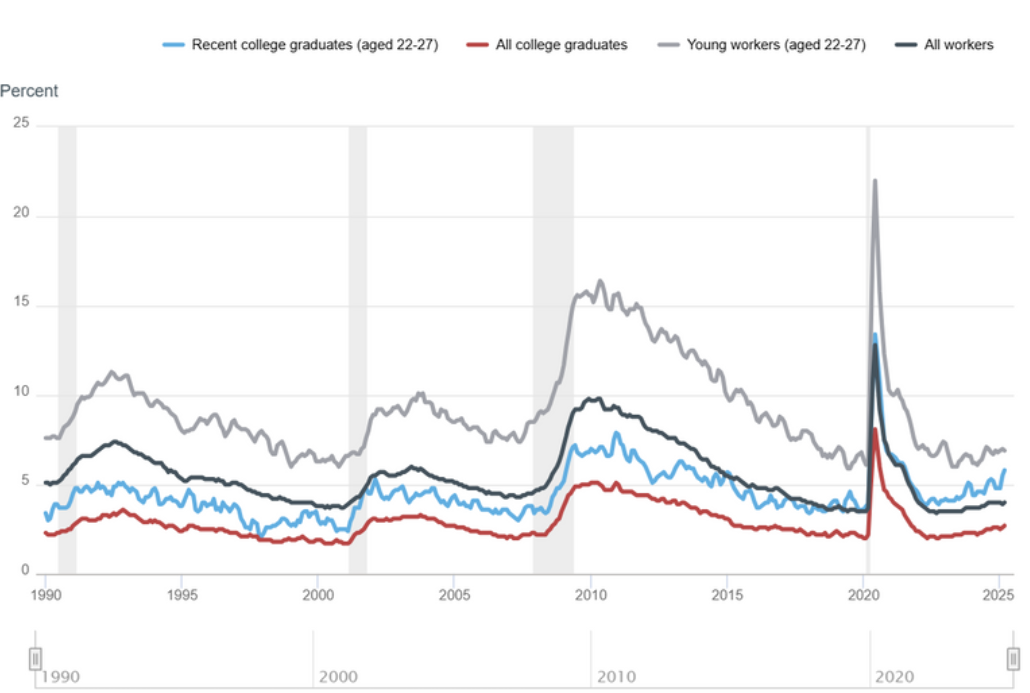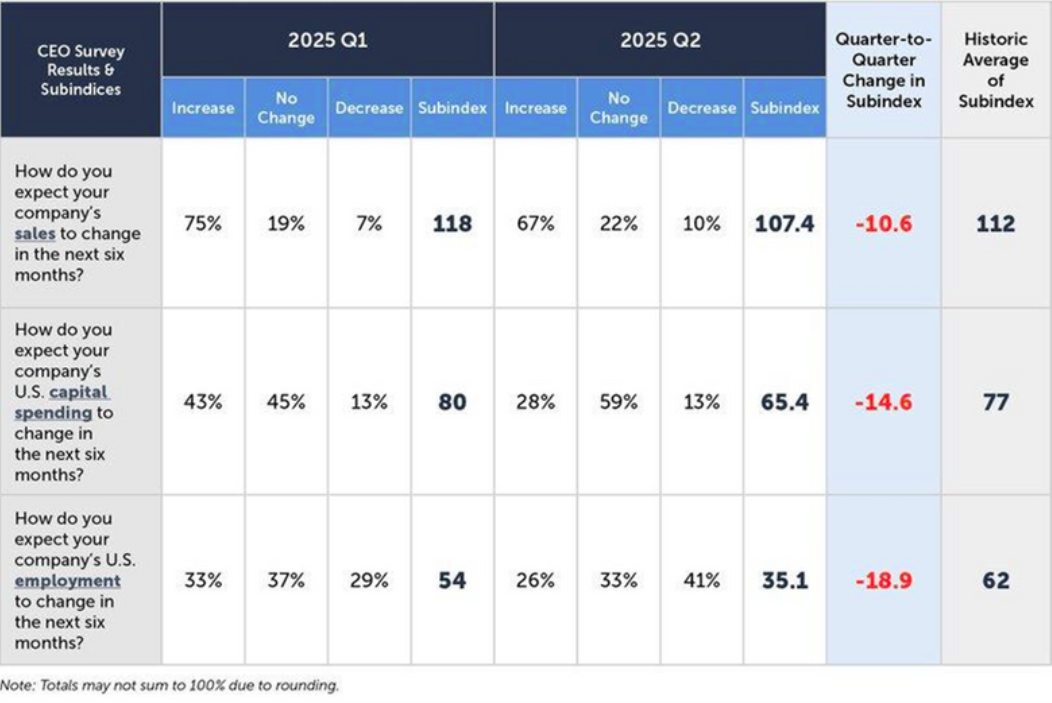2025 Mid-Year Labor Market Report
August 11, 2025
Back in January, I wrote in this report that there were lots of unknowns that might impact the U.S. labor market in 2025. Halfway through the year, guess what? The picture isn’t much clearer. Here’s what’s happened that is important for you to know.
Job and Wage Growth
1. The U.S. Department of Labor (USDOL) reports that 147,000 new jobs were added to the economy in June of 2025. This number is consistent with the average of 146,000 new jobs for each of the previous 12 months.
2. The use of AI continues to impact job growth worldwide. Significant impact has already been felt in many industries, and future impacts are not really known. There are lots of predictions and estimates, though. Here are just a few:
- Goldman Sachs projects that up to 300 million jobs could be lost worldwide because of AI. Check out the full BBC report.
- PatentPC projects that up to 20 million manufacturing jobs could be automated and replaced by 2030. Read more about the manufacturing job impact.
- Bloomberg reports that Wall Street expects to replace 200 roles within the next three to five years. Find more.
- McKinsey estimates that by 2030, 14% of employees worldwide will be forced to change careers because of AI. This report, along with many others on AI topics, is available at McKinsey.com.
3. Looking at wage growth, the USDOL reports that wages and salaries increased by 0.9% during the first quarter of 2025; benefit costs were slightly higher at 1.2% for the same period.
4. USDOL also reports that wages and salaries increased by 3.5% during the 12-month period from March 2024 – March 2025; benefit costs increased by 3.8% during the same period.
Unemployment
The unemployment rate in June 2025 was 4.1%, and has remained in the 4.0%-4.2% range for the last 12 months. Rates close to 4% generally signal recruiting challenges for employers as the number of positions exceeds the number of available candidates.
State unemployment data reported by the USDOL trails federal-level information by one month. In May, only three states (Nevada – 5.5%, Michigan – 5.4% and California – 5.3%) and the District of Columbia (5.9%) had unemployment rates above the national average. South Dakota continued to have the lowest unemployment rate of any state (1.8%).
Despite a low overall unemployment rate, the New York Federal Reserve reports that labor conditions for recent college graduates have “deteriorated noticeably” in the past few months, and the unemployment rate now stands at an unusually high 5.8%. That differs significantly from a trend that spans several decades. The chart below illustrates these changes.

Source: U.S. Census Bureau and US Department of Labor/Bureau of Labor Statistics
Legislative Updates
On April 2, the Trump administration introduced “reciprocal” tariffs aimed at countering what it sees as unfair trade practices inflicted on the United States by other countries. The tariff amounts differed by country and, in some cases, the type of import. Since then, the administration has made multiple changes to the original tariff proposals – there have been way too many changes to even begin to list here. The original tariff proposals imposed a 90-day window for impacted countries to negotiate trade agreements with the U.S. – that window expired on July 8. According to the Peterson Institute for International Economics, an independent research firm, the average trade agreement takes 1.5 years to negotiate and 3.5 years to implement. The uncertainty around this issue has caused businesses to pause plans for investment and expansion. The CEO of Business Roundtable, an association of more than 200 CEOs of U.S. companies, recently stated that “American businesses also need the Administration to rapidly secure deals with our trading partners that open markets, remove harmful tariffs and provide certainty for investment.”
Updates Continued
The first half of 2025 has seen an increased focus on immigration enforcement and workplace compliance. Employers that rely heavily on immigrant labor must be prepared for increased focus on I-9 compliance and the possibility of potential ICE raids. A proactive approach to compliance can mitigate the risk of steep fines and legal challenges.
Immigration Information and Help
Check out our article on “State of Immigration in the Workplace.” Need assistance with reviewing your I-9 forms or training your staff on completing them correctly? View our I-9 services and pricing. Email us at Hello@TheWorkplaceAdvisors.com with any additional questions.
Hot Topics
Economic uncertainty is the key phrase describing the current labor market situation. Business Roundtable, the Association of CEO’s referenced above, recently released its second quarter projections. 169 CEOs completed the survey, which showed projected decreases in sales, capital spending, and most significantly, employment for the second quarter. Their report appears below.

Retail sales reflect consumer behavior and indicate whether consumers feel confident or cautious about their financial condition. The U.S. Census Bureau reports that retail sales fell 0.9% in May, following a decline of 0.1% in April. Consumer spending accounts for about 70% of GDP, so these declines are significant. See the full report.
The manufacturing skills gap in the U.S. could result in 2.1 million unfilled jobs by 2030, according to a study conducted by Deloitte and The Manufacturing Institute. Executives report difficulties filling both higher-paying entry-level production positions and the skilled workers needed for specialized roles. To help address this issue, President Trump issued an Executive Order on April 23 directing the Secretaries of Labor, Commerce, and Education to develop one million new apprenticeships across industries.
Compensation Checklist
- Continue to stay on top of the market by regularly collecting market information. This is critical if you operate in multiple locations, have remote employees, or are expanding to new locations. Salaries can vary widely depending on location.
- If you’re not familiar with pay transparency laws, get up to speed fast. Twenty-five states and the District of Columbia have either passed or are considering legislation of this type. The laws vary and are complex, but a common requirement is that employers list salary ranges on job postings.
- If you’re contemplating changes to your commission, bonus, and/or incentive plans for 2026, now is the time to get started.
- Identify both national and local resources to help you understand market and economic changes and consult them regularly. These changes are occurring rapidly in 2025.
- And if you haven’t developed that annual compensation plan that identifies key tasks for each quarter yet, do it now. It’s critical to staying competitive.